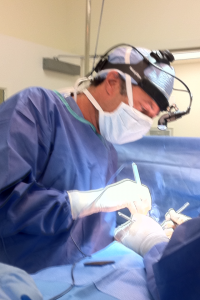Anesthesia and Quality Control
Posted On: August 24, 2012 Author: The Office of Dr. Stuart Linder Posted In: Ambulatory Facility, Home
 Multiple factors are required to achieve a successful outcome in plastic surgery. Not only must the surgeon be Board Certified with the American Board of Plastic Surgery, but the facility should be licensed as ours is with Medicare licensure and the anesthesiologist should be Board Certified with the American Board of Anesthesia. In my practice we only used Certified Diplomates of the American Board of Anesthesia. In other words, Board Certified Anesthesiologists to put our patients to sleep either under IV sedation or general anesthesia. I believe there are no substitutes that Board Certified Anesthesiologists have the experience and judgment to perform anesthesia in a safe and controlled environment. Medicare law requires that a timeout be performed in the operating room. That means before the patient is put to sleep that one of the members of the operating room team will give the patient’s name, specific operation, allergies and antibiotics given. This is referred to as a “timeout.” This is very important to reduce mistakes in the operating room. This is considered standard of care. Interestingly, recently I just operated on a patient who had two breast surgeries here in Beverly Hills in a three-month period with a disastrous outcome. What is most interesting about this patient is specifically that she states not to have seen her plastic surgeon either before surgery, in other words, the doctor was not seen and did not mark the patient, he was not found in the operating room nor was he seen in the preop holding postoperative recovery room after she was extubated. She interestingly did not even see the doctor for the next seven days. In other words, the patient never saw the doctor whatsoever from the beginning of surgery to one week after. It is extremely important that your plastic surgeon mark you himself or herself in the preop holding area, that you see the doctor in the operating room as well as in the postop recovery room. It is also vital to see the surgeon the next day in order for him or her to remove the dressings and place you into your surgical garment. This is considered standard of care in the United States and all patients should be treated by at least the standard. The Board Certified Anesthesiologist that we use has performed well over 7,000 surgeries with me and thankfully has an excellent and perfect record. Complications can occur during the anesthesia and as a result, anesthesiologists who are Board Certified have the experience and training to anticipate and treat these problems to prevent life serious and threatening disasters.
Multiple factors are required to achieve a successful outcome in plastic surgery. Not only must the surgeon be Board Certified with the American Board of Plastic Surgery, but the facility should be licensed as ours is with Medicare licensure and the anesthesiologist should be Board Certified with the American Board of Anesthesia. In my practice we only used Certified Diplomates of the American Board of Anesthesia. In other words, Board Certified Anesthesiologists to put our patients to sleep either under IV sedation or general anesthesia. I believe there are no substitutes that Board Certified Anesthesiologists have the experience and judgment to perform anesthesia in a safe and controlled environment. Medicare law requires that a timeout be performed in the operating room. That means before the patient is put to sleep that one of the members of the operating room team will give the patient’s name, specific operation, allergies and antibiotics given. This is referred to as a “timeout.” This is very important to reduce mistakes in the operating room. This is considered standard of care. Interestingly, recently I just operated on a patient who had two breast surgeries here in Beverly Hills in a three-month period with a disastrous outcome. What is most interesting about this patient is specifically that she states not to have seen her plastic surgeon either before surgery, in other words, the doctor was not seen and did not mark the patient, he was not found in the operating room nor was he seen in the preop holding postoperative recovery room after she was extubated. She interestingly did not even see the doctor for the next seven days. In other words, the patient never saw the doctor whatsoever from the beginning of surgery to one week after. It is extremely important that your plastic surgeon mark you himself or herself in the preop holding area, that you see the doctor in the operating room as well as in the postop recovery room. It is also vital to see the surgeon the next day in order for him or her to remove the dressings and place you into your surgical garment. This is considered standard of care in the United States and all patients should be treated by at least the standard. The Board Certified Anesthesiologist that we use has performed well over 7,000 surgeries with me and thankfully has an excellent and perfect record. Complications can occur during the anesthesia and as a result, anesthesiologists who are Board Certified have the experience and training to anticipate and treat these problems to prevent life serious and threatening disasters.